Jebel Qatrani Formation
The Jebel Qatrani Formation (also Gebel Qatrani, Gabal Qatrani or Djebel Qatrani) is a geologic formation located in the Faiyum Governorate of central Egypt. It is exposed between the Jebel Qatrani escarpment and the Qasr el Sagha escarpment, north of Birket Qarun lake near Faiyum. The formation conformably overlies the Qasr el Sagha Formation and is topped by the Widan el Faras Basalt. The age of the formation has been subject to debate, but the most recent research indicates that it covers both the latest parts of the Eocene and the Early Oligocene, spanning over the boundary between these two time periods.
| Jebel Qatrani Formation | |
|---|---|
| Stratigraphic range: Eocene-Oligocene ~ | |
 | |
| Type | Formation |
| Sub-units | Lower Sequence (Lower Fossil Wood Zone)
Barite Sandstone Upper Sequence (Upper Fossil Wood Zone) |
| Underlies | Widan el Faras Basalt |
| Overlies | Qasr el Sagha Formation |
| Area | Fayum Depression |
| Thickness | 340 m |
| Lithology | |
| Primary | sandstone, mudstone |
| Location | |
| Region | Faiyum Governorate |
| Country | |
The geology and fauna of this formation gives a good idea of the environment and animals present during this time period. Research suggests that the Jebel Qatrani Formation featured a mix of subtropical to tropical forest, lowland swamps and marshes, ponds and rivers that would empty northward into the Tethys Sea. This is supported by the presence of water-dependent fauna including podocnemidid turtles, crocodilians, sea cows, various fish, jacanas, early flamingo-relatives, ospreys, herons and shoebills.
Besides these, the fossil record of the Jebel Qatrani Formation is especially well known for its value to understanding the early evolution of many modern mammal groups. Primates are represented by over a dozen genera, several forms of early elephants have been recovered from the sediments including the terrestrial Phiomia and the semi-aquatic Moeritherium. The fossil rodents of the formation meanwhile are thought to be an important link between the African phiomorphs (dassies, old world porcupines, mole rats and cane rats) and the caviomorphs of South America (capybaras, chinchillas and new world porcupines). Besides these early members of groups that would later rise to prominence, the formation was also home to a variety of unique groups no longer found today or only found in a greatly diminished diversity. This includes the enigmatic, possibly carnivorous ptolemaiids, large hyaenodonts, a vast number of highly diverse hyracoids including species the size of rhinos, anthracotheres and the bizarre embrithopod Arsinoitherium.
Geography and history
)_(17971592490).jpg.webp)
Outcrops of the Jebel Qatrani Formation are present in the northern Fayum Depression southwest of Cairo.[1] The Fayum Depression is an oasis west of the Nile in northern Egypt.[2]
The formations of the Fayum have been studied for a significant amount of time by numerous paleontologists, with research dating back to as early as the 19th century. During this time the region was studied extensively by scientists including but not limited to Charles William Andrews, Henry Fairfield Osborn, René Fourtau and Ernst Stromer. Among the first names for what is now known as the Jebel Qatrani formation was the “Fluvio-Marine Series”, as coined by Hugh J. L. Beadnell. However, despite the bulk of research conducted in the late 19th and early 20th century, the Fayum localities would eventually enter a period of obscurity following the outbreak of World War I which continued throughout the mid 20th century and World War II. Research resumed during the 1960s, following an expedition under Elwyn LaVerne Simons.[2] Previously, the formations of the region had been primarily known for the preservation of mammals, but Birds were also known from few specimens uncovered in the early 20th century. During the 60s, improved collection methods and additional expeditions by the Yale and Duke University gathered much additional material in association with the Egyptian Geological Survey and the General Petroleum Company.[1] Around the 70s, the scope of the expedition was broadened to account for more diverse fields of study, leading to more precise datings of the strata.[2]
Geology and stratigraphy
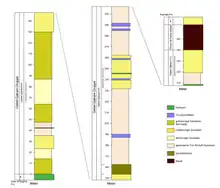
The formation overlies the Eocene Qasr el Sagha Formation and is overlaid by the Oligocene Widan el Faras Basalt. The formation contains at least two major fossil bearing layers, one in the upper sequence, which is used to refer to the top layers of the formation, and a second in the lower sequence. These two layers have also been called the Upper and Lower Fossil Wood Zones in older publications. Both sequences of the Jebel Qatrani Formation are separated from one another by the so-called Barite Sandstone, a layer with a thickness of 4–10 m (13–33 ft).[1][2]
The dating of the Jebel Qatrani Formation has historically been under debate, with some research having placed it either entirely within the Eocene or Oligocene and some arguing that it spans both periods. Rasmussen and colleagues for instance argued that the central Barite Sandstones separating both fossil bearing layers mark the exact Eocene-Oligocene Boundary. Part of the reasoning for this connects to the primate fauna of the formation, with propliopithecids and parapithecines only appearing in the upper localities. Other dating methods meanwhile have generally not been applicable. According to Seiffert, the mammal fauna of the formation on its own is too endemic and marine invertebrates are absent, preventing biostratigraphic dating. Radioisotopic dating was conducted on the overlying Widan el Faras Basalt, however the results of this suggested an age of 23.6 million years for its lower units, much younger than prior estimates for the Jebel Qatrani Formation. However, in a 2006 publication Seiffert draws a comparison between the Fayum fauna and the fossil record of the Ashawq Formation in Oman, which notably preserved vertebrates as well as foraminifera useful in dating. Foraminifera biostratigraphy and magnetostratigraphy suggest that the examined localities in Oman date to approximately 31-31.5 (Taqah locality) and 33.7-33.3 Ma (Thaytiniti locality). Seiffert argues that the mammal fauna from Oman most closely resembles those found in the oldest localities of the Lower Sequence of the Jebel Qatrani Formation (L-41) and the oldest localities of the Upper Sequence (quarries G and V). The hyraxes Thyrohyrax and Saghatherium occur in both formations, as does the primate Moeripithecus. More generally, both formations preserve propliopithecids and parapithecine parapithecids as well as oligopithecids. While the former two groups are restricted to the younger Fayum sequence, the latter is the most common primate family in the older sediments. Assuming the traditional interpretation of the Jebel Qatrani Formation, this would mean that many of these taxa would have had to appear 2 to 4 million years earlier in Egypt than in Oman, which is considered to be unlikely by Seiffert. According to them the formation spans approximately 8 million years, with its oldest localities situated in latest Eocene strata. Locality BQ-2 has been estimated to be 37 million years old (early Priabonian), while L-41 falls into an age range of 34.8–33.7 million years old, a timespan that includes the Eocene-Oligocene Boundary. Although an earliest Oligocene age could not be disproven by Seiffert, he argues that a latest Eocene age should be considered more likely based on an unconformity present just above the locality (one also acknowledged as a possible candidate for the EOB by Rasmussen). This means that only the lower 48 m (157 ft) of the formation are Eocene in age, including both the BQ-2 and L-41 localities. The remainder of the Lower Sequence, as well as the entire Upper Sequence, would subsequently fall within the Oligocene. The position of quarries A and B in regards to the boundary is ambiguous, however Quarry E on the other hand is considered without doubt Oligocene (ca. 33 Ma) in age by Seiffert.[3]
Paleoenvironment
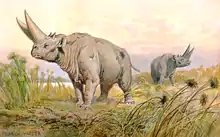
The environment of the Jebel Qatrani formation has been described as a subtropical to tropical lowland plain by Bown, who further suggests the presence of streams and ponds. Based on the fossil bird remains, which includes the fossils of a variety of animals highly associated with water (ospreys, early flamingos, jacanas, herons, storks, cormorants and shoebills), Rasmussen and colleagues inferred that the environment featured slow-moving freshwater with a substantial amount of aquatic vegetation, which matches the prior hypothesis. Although lithology suggests that most fossils were deposited on sandbanks after being transported by currents, the authors argue that swamps could have easily formed along the banks of the river that was present during the Oligocene and may account for the mudstone found in certain quarries. They furthermore suggest that the fossil birds of Fayum, due to their affinities with modern groups, should be considered a more valuable indicator of the environment when compared with the fossil mammals, many of which belonged to families lacking modern examples. The absence of other birds typical for such an environment may be explained either through sampling bias or due to the fact that said groups had simply not yet been present in Oligocene Africa. Generally, Rasmussen and colleagues compare the environment of Jebel Qatrani to freshwater habitats in modern Central Africa.[1] The discovery of snakehead fossils seem to support Rasmussen's interpretation, as the genus Parachanna today prefers slow-moving backwaters with plenty of vegetation. Other fish present meanwhile, notably Tylochromis, suggest that deep, open water was likewise present. The river channels may have been overgrown with reeds, papyrus and featured floating vegetation like water lilies and Salvinia.[4] In a 2001 paper Rasmussen et al. argued that the sandstone and mudstone of the formation likely formed as sediments were aggraded by a system of river channels that emptied towards the west into the Tethys. Here they reconstructed the environment as a tropical lowland swamp forest intermingled with marshes. They furthermore suggest that the environment would have experienced monsoons.[5] Overall this indicates that this region was a part of an extensive belt of tropical forest that stretched across what is now northern Africa, which would gradually give rise to open woodland and even steppe the further one was to travel inland.[2]
Paleobiota
Fish
Actinopterygii
| Name | Species | Member | Locality | Material | Notes | Image |
|---|---|---|---|---|---|---|
| Alestidae indet.[4] | Lower and Upper Sequence | Quarry E, I, M, R & X | Various teeth | Different teeth belonging to Characiformes, they are common across both fossil bearing members. A large range of tooth morphotypes is present in the formation, however this may not reflect the actual diversity of African tetra species present. | ||
| Amiiformes indet.[4] | ||||||
| Lates[4] | Lates sp. | Lower and Upper Sequence | Quarry E, I, M & V | Two crania and various other isolated material. | Its absence from the lacustrine L-41 environment might indicate that the water was too shallow. Modern Lates can grow large and prefer large lakes and rivers. | |
| Parachanna[4] | Parachanna fayumensis | Lower and Upper Sequence | Quarry L-14, P & M | Various cranial remains including a dentary. | A snakehead fish, the Jebel Qatrani material may suggest that this group arrived in Africa earlier than it had been previously thought. | |
| Siluriformes indet.[4] | Lower and Upper Sequence | Quarry L-41, B, G, E, I, J, K, M, P & V | Three skulls and various postcranial remains, predominantly fin spines. | The three known skulls are approximately the same size, but may not represent the same taxon. The postcranial elements indicate a greater size range. In some aspects the Jebel Qatrani catfish resemble the genus Fajumia. | ||
| cf. Tylochromis[4] | Lower and Upper Sequence | Quarry E, I & X | A lower jaw and additional material including teeth. | A basal cichlid. | ||
Chondrichthyes
| Name | Species | Member | Locality | Material | Notes | Image |
|---|---|---|---|---|---|---|
| Dasyatoidea indet.[4] | ||||||
| Lamniformes indet.[4] | ||||||
Sarcopterygii
| Name | Species | Member | Locality | Material | Notes | Image |
|---|---|---|---|---|---|---|
| Dipnoi indet.[4] | Quarry L-41 | |||||
Reptiles
| Name | Species | Member | Locality | Material | Notes | Image |
|---|---|---|---|---|---|---|
| Albertwoodemys[6] | Albertwoodemys testudinum | Lower Sequence | A locality west of the AMNH quarries. | A partial plastron with articulated peripheral elements of the upper shell. | A side-necked turtle of the family Podocnemididae with a high-domed shell likely similar to tortoises. It may be a related taxon to specimen UCMP 42008, from the Miocene of Kenya. | |
| Andrewsemys[6][7] | Andrewsemys libyca | North of Lake Qarun | Various shell remains. | A side-necked turtle of the family Podocnemididae previously known as "Stereogenys" lybica. The holotype specimen, among the best preserved turtle shells from Fayum, was thought to be lost before being rediscovered and used to erect a new genus. Several additional specimens are known from the Jebel Qatrani and its underlying formations. | ||
| "Crocodylus" megarhinus[8] | Various cranial and mandibular remains | A large and broad-snouted species of crocodilian incorrectly assigned to Crocodylus. A second Fayum crocodile, "Crocodylus" articeps, has been considered a younger individual of this species by Christopher Brochu. | ||||
| Dacquemys[6][9] | Dacquemys paleomorpha | Lower Sequence | Quarry B | A nearly complete skull | A side-necked turtle of the family Podocnemididae that may be a related taxon to specimen UCMP 42008. It is possible that Dacquemys represents skull material of Albertwoodemys. | |
| Eogavialis[8] | Eogavialis africanum | An early genus of gavialoid common in the formation. Two species have originally been named from Jebel Qatrani,Eogavialis gavialoides and Eogavialis tenuirostre (both originally as Tomistoma), however recent research suggests that all Fayum Eogavialis species including those of other formations in the region may simply represent a single species.[2] | ||||
| Gigantochersina[10] | Gigantochersina ammon | Lower Sequence | Quarry A & B | Multiple specimens including a nearly complete carapace and plastron as well as a partial pelvis | The oldest known tortoise from Africa. Testudo beadnelli and Testudo isis were both named, but have since then been synonymized with G. ammon.[2] | |
| Neochelys[6] | Neochelys fajumensis | Lower and Upper Sequence | Quarry L-41, A, B, C, I, M, O, P & R | Various remains of the plastron and carapace as well as skull material. | A side-necked turtle of the family Podocnemididae, similar to Erymnochelys and previously assigned to said genus. The type specimen, an anterior plastron, has potentially been lost. They are among the most common fossils in the quarries L-41, I and M. | |
| Varanidae indet.[2] | Upper Sequence | Quarry I | A presacral vertebra | I single bone described by Smith et al. and originally assigned to the genus Varanus. Later research by Holmes et al. suggests it was a stem-varanid, distinct from other remains found in the formation. | ||
| Varanus[2] | Upper Sequence | Quarry I & M | Vertebrae | Isolated bones described by Holmes et al. and considered to be part of the modern genus Varanus. They argue that this represents the oldest known member of the genus and indicates an African origin for modern monitor lizards. | ||
Birds
Accipitriformes
| Name | Species | Member | Locality | Material | Notes | Image |
|---|---|---|---|---|---|---|
| Accipitridae indet., aff. Haliaeetus[1] | Lower Sequence | Quarry A | The distal end of a tarsometatarsus. | A bird of prey similar in size and morphology to the modern sea eagles. The early strata of the formation indicate closer proximity to the shore, possibly supporting a lifestyle similar to modern Haliaeetus species. | ||
| Pandionidae indet., aff. Pandion[1] | Upper Sequence | Quarry M | The distal end of a humerus. | A fossil nearly identical to the extant osprey, but smaller. | ||
| Pandionidae? indet.[1] | Upper Sequence | Quarry I | A damaged carpometacarpus. | A raptorial bird approximately the size of the extant osprey, however more robust. | ||
Charadriiformes
| Name | Species | Member | Locality | Material | Notes | Image |
|---|---|---|---|---|---|---|
| Janipes[1] | Janipes nymphaeobates | Upper Sequence | Quarry M | The distal end of a tarsometatarsus | A large species of jacana, exceeding all modern taxa in size but still smaller than Nupharanassa bulotorum. The Fayum jacanas already show signs of a lifestyle like that of their modern relatives and subsequently may indicate a dense floating vegetation. | |
|
Nupharanassa[1] |
Nupharanassa bulotorum | Upper Sequence | Quarry M | Multiple specimens preserving the tarsometatarsus. | A large species of jacana, between 30 and 35% larger than the largest extant species, the bronze-winged jacana. | |
| Nupharanassa tolutaria | Lower Sequence | Quarry E | The distal end of a tarsometatarsus. | A smaller relative of Nupharanassa bulotorum, it is distinguished by its much smaller size and older age. It is the only known jacana in the lower sequence of the Jebel Qatrani Formation. | ||
Ciconiiformes
| Name | Species | Member | Locality | Material | Notes | Image |
|---|---|---|---|---|---|---|
| Palaeoephippiorhynchus[1] | Palaeoephippiorhynchus dietrichi | Upper Sequence | Quarry M | A nearly complete rostrum with mandible and partial cranium and the distal end of a right tibiotarsus. | A large stork comparable in size to the modern jabiru and marabou stork. While the type material bears great resemblance to the extant saddlebill, a tibiotarsus found in a different quarry shares no similarities with any modern taxa and may or may not belong to Palaeoephippiorhynchus. | |
Cuculiformes
| Name | Species | Member | Locality | Material | Notes | Image |
|---|---|---|---|---|---|---|
| Musophagidae indet., aff. Crinifer[1] | Upper Sequence | Quarry M | The distal ends of a tarsometatarsus and a humerus. | A relatively large type of turaco and among the earliest recorded members of the group. It shares similarities to the extant genus Crinifer. | ||
Gruiformes
| Name | Species | Member | Locality | Material | Notes | Image |
|---|---|---|---|---|---|---|
| Gruidae indet.[1] | Upper Sequence | Quarry M | The distal end and partial shaft of a tarsometatarsus. | A bird bearing resemblance to modern crowned cranes, cranes of the genus Grus and the limpkin. Its size is between that of the limpkin and the demoiselle crane, although closer to the former. | ||
| Rallidae indet.[1] | Upper Sequence | Quarry M | The distal end of a tarsometatarsus. | Possibly a type of rail bearing resemblance to the genera Sarothrura, Coturnicops and Laterallus. | ||
Palaeognathae
| Name | Species | Member | Material | Notes | Image |
|---|---|---|---|---|---|
| Eremopezus[1][5] | Eremopezus eocaenus | Lower Sequence | Various fragmentary leg bones including the distal end of a tibiotarsus and the distal end of a tarsometatarsus. | An enigmatic large groundbird comparable in size to a modern rhea. It was initially thought to be a type of ratite, but its relationship with other birds has repeatedly been questioned. Stromeria fajumensis, found in the same formation, is thought to be synonymous with Eremopezus. | |
Pelecaniformes
| Name | Species | Member | Locality | Material | Notes | Image |
|---|---|---|---|---|---|---|
| Ardeidae indet.[1] | Upper Sequence | Quarry I & M | A partial rostrum, a distal tarsometatarsus of a juvenile specimen and the first phalanx of the third toe. | A medium-sized heron comparable in size to the reddish egret and the great white egret. The lack of overlapping material means that it is uncertain if these fossils represent one or several species. | ||
| Goliathia[1] | Goliathia andrewsi | Lower and Upper Sequence | Quarry M | A complete ulna and the distal end of a tarsometatarsus. | A large relative of the modern shoebill. |  |
| Nycticorax[1] | Nycticorax sp. | Upper Sequence | Quarry M | A nearly complete tarsometatarsus and a coracoid. | A bird who's remains are described as being identical to that of the extant black-crowned night heron, indicating that night herons diverged from other herons at least 31 million years ago. | |
| Xenerodiops[1] | Xenerodiops mycter | Upper Sequence | Quarry I & M | A nearly complete rostrum and a humerus lacking its distal end. | An unusual heron with a heavy and downwards curved beak. | |
Phoenicopteriformes
| Name | Species | Member | Locality | Material | Notes | Image |
|---|---|---|---|---|---|---|
| Phoenicopteridae indet. Species 1, aff. Palaelodus[1] | Upper Sequence | Quarry M & I | Multiple specimens including the tibiotarsus and parts of the metacarpals. | Several bones of the Fayum phoenicopteriform show both similarities to derived flamingos as well as to the more basal Palaeolodus, which Rasmussen and colleagues considered Phoenicopterids rather than placing it within its own family. The material suggests a bird approximately the size of Palaelodus gracilipes. | ||
| Phoenicopteridae indet. Species 2[1] | Upper Sequence | Quarry M | A coracoid fragment | A second, larger phoenicopteriform, closer in size to Palaeolodus crassipes and the lesser flamingo. | ||
Suliformes
| Name | Species | Member | Locality | Material | Notes | Image |
|---|---|---|---|---|---|---|
| Phalacrocoracidae indet.[1] | Upper Sequence | Quarry M | A distal premaxilla. | An indetermined cormorant showing a more gradually tapering and more strongly hooked beak. Among modern cormorants, it most closely resembles the guanay cormorant. | ||
Mammals
Afroinsectivora
| Name | Species | Member | Locality | Material | Notes | Image |
|---|---|---|---|---|---|---|
| Eochrysochloris[11] | Eochrysochloris tribosphenus | Lower Sequence | Quarry E | A tiny member of the Afrosoricida. | ||
| Herodotius[12] | Herodotius pattersoni | Lower Sequence | Quarry L-41 | Fossils of the dentary and maxilla. | A species of elephant shrew. | |
| Jawharia[13][11] | Jawharia tenrecoides | Lower Sequence | Quarry E | A relative of tenrecs and golden moles. | ||
| Metoldobotes[2] | Metoldobotes stromeri | A genus of elephant shrew. | ||||
| Qatranilestes[13][11] | Qatranilestes oligocaenus | Upper Sequence | Quarry I | A badly preserved mandible. | The most derived member of the Afrosoricida in the formation. | |
| Widanelfarasia bowni | Lower Sequence | Quarry L-41 | A stem-afrosoricid. | |||
| Widanelfarasia rasmusseni | Lower Sequence | Quarry L-41 | ||||
Artiodactyla
| Name | Species | Member | Locality | Material | Notes | Image |
|---|---|---|---|---|---|---|
| Bothriogenys andrewsi | Upper Sequence | L-75 | Teeth and dentary remains. | A large anthracothere from the uppermost levels of the formation. |
 Bothriogenys fraasi (foreground) | |
| Bothriogenys fraasi | Upper Sequence | Quarry I | A species of Bothriogenys arising from B. gorringei. It may have either split into two lineages or given rise to B. andrewsi through anagenesis. | |||
| Bothriogenys gorringei | Lower Sequence | Quarry M | Originally described based on a mandible. | The oldest species of Bothriogenys in Jebel Qatrani, it may have split into two lineages giving rise to B. fraasi and B. rugulosus. It may have been a semi-aquatic browser or grazer, feeding primarily on foliage. | ||
| Bothriogenys rugulosus | Upper Sequence | A species of Bothriogenys that likely evolved from B. gorringei. | ||||
| Nabotherium[16][18][2] | Nabotherium aegyptiacum | A partial skull, several fossils of the mandible and maxilla as well as isolated teeth. | An anthracothere with well developed canine teeth. Its dentition is better suited to crushing fruit rather than slicing vegetation. | |||
| Qatraniodon[14][16][19] | Qatraniodon parvus | Lower Sequence | The holotype consists of a partial mandible. | The smallest anthracothere from the Jebel Qatrani Formation and not as common than Bothriogenys. | ||
Chiroptera
| Name | Species | Member | Locality | Material | Notes | Image |
|---|---|---|---|---|---|---|
| Dhofarella[20][21] | Dhofarella sigei | Lower Sequence | Quarry L-41 | A left dentary. | A type of sheath-tailed bat. | |
| Khonsunycteris[20] | Khonsunycteris aegypticus | Lower Sequence | Quarry L-41 | A left dentary. | A type of vesper bat. | |
| Phasmatonycteris[22][20] | Phasmatonycteris phiomensis | Upper Sequence | Quarry I | Dentary remains. | A type of sucker-footed bat. | |
| Philisis[20][21] | Philisis sphingis | Upper Sequence | Quarry I | Material of the maxilla and dentary. | A philisid bat related to the older Witwatia from Birket Qarun. | |
| Saharaderma[20] | Saharaderma pseudovampyrus | Lower Sequence | Quarry L-41 | A right dentary. | A type of false vampire bat. | |
| Vampyravus[20][21] | Vampyravus orientalis | Upper Sequence | A large humerus. | A bat of uncertain affinities. It was the first fossil bat discovered in Africa and the largest bat of the Fayum succession, weighing up to 120 g (4.2 oz). This puts it within the size range of the Egyptian fruit bat. | ||
Embrithopoda
| Name | Species | Member | Locality | Material | Notes | Image |
|---|---|---|---|---|---|---|
| Arsinoitherium[23][24] | Arsinoitherium zitteli | Lower and Upper Sequence | Just above Quarry L-41 to Quarry M, spanning most of the sequence. | A large arsinoitheriid embrithopod well known for its two horns. A large amount of material is known and in the past a second species from Jebel Qatrani, A. andrewsi, has been proposed. Some researchers however consider it to be a synonym of A. zitteli with the differences possibly being caused by sexual dimorphism. |  Arsinoitherium zitteli skull | |
Hyaenodonta
| Name | Species | Member | Locality | Material | Notes | Image |
|---|---|---|---|---|---|---|
| Akhnatenavus leptognathus | Lower Sequence | Quarry A | A slender mandible. | A member of the Hyainailourinae, it was originally described as Pterodon leptognathus. It was smaller than the two other "Pterodon" species from Jebel Qatrani and Metapterodon. | 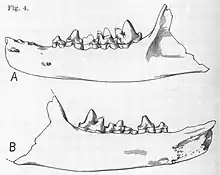 | |
| Akhnatenavus nefertiticyon | Lower Sequence | Quarry L-41 | A complete cranium as well as a palate and dentary. | A second species of Akhnatenavus smaller than A. leptognathus. The skull also appears to have been much shorter than in the type species. Calculations resulted in an average bodymass of 19.2 kg (42 lb), approximately as large as a Eurasian lynx or wolverine. | 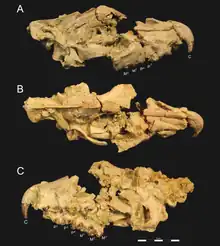 | |
| Apterodon altidens | Lower Sequence | Described based on a maxilla. | Although named in 1910, A. altidens was not properly described until 1911. A mandible was also referred to this species, but this decision has been considered dubious by Lange-Badré and Böhme. | |||
| Apterodon macrognathus | Lower Sequence | Quarry A & B | Skulls and mandibles | A hyaenodont originally described as a species of Pterodon. |  | |
| Brychotherium[25][30] | Brychotherium ephalmos | Lower Sequence | Quarry L-41 | Multiple lower jaws and parts of the rostrum. | A teratodontine hyaenodont approximately as heavy as a modern red fox or American badger. Although the name was coined in a dissertation in 1994, it was not formally described until 2016. | 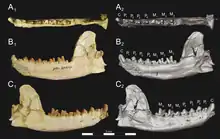 |
| Falcatodon[31][32][27] | Falcatodon schlosseri | Upper Sequence | Quarry V | Described based on a left dentary. | Erected by Holroyd as a species of Metapterodon, it was even then noted to be possibly distinct. Morales and Pickford later raised it to a distinct genus. There may be additional material from Quarry B in the lower sequence, however the assignment of said fossils is only tentative. |  |
| Masrasector aegypticum | Upper Sequence | Quarry G | Dental remains | A teratodontine hyaenodont smaller than Brychotherium. | ||
| Masrasector nananubis | Lower Sequence | Quarry L-41 | Skulls, mandibles and multiple humeri. | A smaller species of Masrasector from older deposits. Its estimated body size was within the range of modern striped skunks and small-spotted genets. The limb bones indicate it was a fast runner that could have hunted the local rodents. | 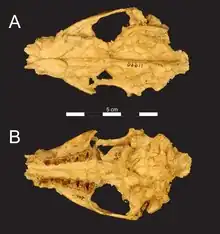 | |
| Metapterodon[26][27][15] | Metapterodon brachycephalus | Lower Sequence | Quarry A | A left dentary. | Named as a species of Hyaenodon, it was eventually placed in Metapterodon by Holroyd. While Morales and Pickford restrict the genus to the Miocene and place Holroyd's other species in separate genera, they do not mention M. brachycephalus. | 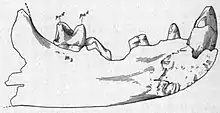 |
| Metasinopa[26][25][30] | Metasinopa fraasi | Upper Sequence | A nearly complete lower jaw. | A possible relative to teratodontines, although its exact relationship with other hyaenodontids needs more testing. It was larger than Masrasector. | 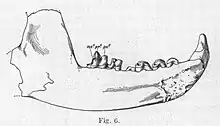 | |
| "Pterodon" africanus | Lower Sequence | Quarry A | Mandibles, a rostrum and an assigned neck vertebra. | The first hyaenodont described from Fayum, later analysis showed that it was much more derived than Pterodon dasyuroides, the type species. Consequently, a different genus name is required. |  | |
| "Pterodon" phiomensis | Lower Sequence | Quarry A | A mandible smaller than that of "P." africanus. | Like "P." africanus, "P." phiomensis is much more derived than the type species of Pterodon and thus requires a different genus name. Furthermore, analysis showed that it was not closely related to "P." africanum either. It is most closely allied with the clade formed by Akhnatenavus, Isohyaenodon and Hyainailouros. |  | |
| "Pterodon" sp. | Lower Sequence | Quarry E | A broken canine. | An isolated tooth similar in size to "P." phiomensis. | ||
| "Pterodon" syrtos | Upper Sequence | Quarry M | A right maxilla fragment. | |||
| Quasiapterodon[29][2][31][33] | Quasiapterodon minutus | Upper Sequence | Originally named as a species of Apterodon alongside A. altidens, later research showed it clearly differed from this genus. It may instead be related to "Sinope" ethiopica. | |||
| Sectisodon[31][32][27] | Sectisodon markgrafi | A left maxilla. | S. markgrafi was initially named by Holroyd as a species of Metapterodon in 1999, but placed in the new genus Sectisodon by Morales and Pickford in 2017. | |||
| "Sinopa"[34][25][29][35] | "Sinopa" ethiopica | A mandibular ramus. | A hyaenodont originally described as a species of Sinopa, although later research clearly shows that it does not belong to the American-Asian genus. Its exact relation to other hyaenodonts remains uncertain until further study, however it has been suggested to be a relative of Quasiapterodon. | |||
Holroyd also identified several indetermined pterodontine hyaenodonts from various sequences of the Jebel Qatrani Formation, but doesn't identify them beyond subfamily level.[27]
Hyracoidea
| Name | Species | Member | Locality | Material | Notes | Image |
|---|---|---|---|---|---|---|
| Antilohyrax[36][37] | Antilohyrax pectidens | Lower Sequence | Quarry L-41 | Mandibles, a crushed cranium as well as various incomplete skull fossils and postcranial elements. | A gazelle-like titanohyracine described in 2000. The teeth and limb bones indicate that it was a cursorial browser, similar to modern antelopes and gazelles. | |
| Bunohyrax fajumensis[38][39][40] | Lower and Upper Sequence | Described based on a mandible. | Bunohyrax species were medium-sized hyracoids somewhat resembling pigs in their dentition. They may have been related to Pachyhyrax. | |||
| Bunohyrax major[38][40] | Upper Sequence | Described based on three premolars. | Originally named Geniohyus major, B. major is larger than B. fajumensis. Additionally, its teeth are more bunodont. | |||
| Bunohyrax sp.[36] | Lower Sequence | Quarry L-41 | ||||
| Geniohyus diphycus[41] | Lower Sequence | A medium-sized species. Geniohyus is among the rarer hyracoids of Jebel Qatrani. | ||||
| Geniohyus magnus[40][41] | Lower and Upper Sequence | Quarry V | Various skull remains including maxillary fragments and dentary remains. | It is the smallest species of Geniohyus, with the name originating when it was still considered a part of Saghatherium. Its dentition forms an intermediate between other Geniohyus and Bunohyrax. | ||
| Geniohyus mirus[38][40][41] | Lower Sequence | Described based on a mandible. | The largest of the three named Fayum Geniohyus species and the type species. | |||
| Geniohyus sp.[36] | Lower Sequence | Quarry L-41 | Geniohyus takes the species name from their morphological similarities to pigs, with early research even classifying them as suids. | |||
| Megalohyrax eocaenus[36][38][39][40] | Upper Sequence | Described based on premaxillary and maxillary material. Also includes mandibular remains. | Megalohyrax show strong sexual dimorphism in regards to their body size. It was a common genus in formation. | |||
| Megalohyrax sp.[36][38] | Lower Sequence | Quarry L-41 | An unnamed species of Megalohyrax preserving an interior mandibular fenestra unlike the younger M. eocaenus. | |||
| Pachyhyrax[36][38][39][41] | Pachyhyrax crassidentatus | Upper Sequence | Quarry I, L-46 & M | Skulls, mandibles and teeth including the complete but crushed skull of a young individual. | A hyracoid resembling the contemporary anthracothere Bothriogenys. It is possible that it was a semi-aquatic herbivore. | |
| Saghatherium antiquum[38][43][40][41] | Lower Sequence | Described based on a maxilla | Saghatherium had heavy jaws and possibly fed on nuts and seeds. Furthermore, members of this genus display pronounced sexual dimorphism and may have had complex mating rituals. The species S. sobrina was shown to simply represent female individuals of this species. |
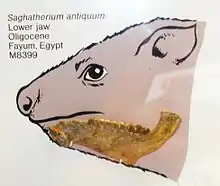 | ||
| Sagahtherium humarum[41] | Upper Sequence | Quarry V | Dentaries and teeth. | A small Saghatherium species that differs due to the presence of an internal chamber in the mandible. | ||
| Saghatherium bowni[36][38][43] | Lower Sequence | Quarry L-41 | A common species of Saghatherium named in 1991. | |||
| Selenohyrax[36][38][41] | Selenohyrax chatrathi | Upper Sequence | Quarry V | Several mandibles. | A hyracoid named for its selenodont teeth (molars with crescent-shaped ridges), which are much more developed than in Titanohyrax. These teeth indicate a diet that required it to slice vegetation rather than grind it. It is a small hyrax, only slightly larger than Saghatherium which it might have descendet from. | |
| Thyrohyrax domorictus[38][39] | Upper Sequence | Quarry I, G, L-46, M, P, R, V & X | Primarily mandibular remains and teeth, but also some limb elements and vertebrae. | Thyrohyrax is among the smaller hyracoids of Fayum and resembles today's arboreal Dendrohyrax. Species of Thyrohyrax display little size-related sexual dimorphism, however males do possess enlarged, tusk-like second incisors and chambered mandibles. | ||
| Thyrohyrax litholagus[36][43] | Lower Sequence | Quarry L-41 | A relative of the younger Thyrohyrax pygmaeus, it was somewhat larger than T. meyeri. | |||
| Thyrohyrax meyeri[36][38][43] | Lower Sequence | Quarry L-41 | T. meyeri was very similar to the younger T. domorictus and may have been a close relative. | |||
| Thyrohyrax pygmaeus[38][41] | Lower Sequence | Quarry A-1 | The front of a skull with an associated mandible as well as several teeth from another specimen. | A close relative of direct descendent of T. litholagus. It was originally assigned to Saghatherium magnum, then described as a species of Megalohyrax before being moved into Pachyhyrax and eventually Thyrohyrax. | ||
| Titanohyrax andrewsi[36][40][41] | Lower Sequence | Five specimen including two mandibles and a single maxilla. | Titanohyrax species are the largest hyracoids of the Fayum Depression and form the clade Titanohyracinae with Antilohyrax. Like their smaller relative, they are thought to have been folivores. The lower incisors of T. andrewsi were shaped like spatulas, rather than tusks. | |||
| Titanohyrax angustidens[36][40][41] | Upper Sequence | Quarry V, R & I | Eight specimen including maxillary, premaxillary and mandibular remains. | T. angustidens has the most complex history among Titanohyrax species, initially assigned to Megalohyrax and given the name M. palaeotheroides, it was later recognized as Titanohyrax and variably considered distinct or synonymous with T. andrewsi. The name T. palaeotheroides was not retained as it was a nomen nudum. | ||
| Titanohyrax ultimus[36][40] | Upper Sequence | Four heavily worn teeth. | The largest species of Titanohyrax, weight estimates for T. ultimus range from 600–1,300 kg (1,300–2,900 lb), making it possibly as large as the modern sumatran rhino. | |||
| Titanohyrax sp.[36] | Lower Sequence | Quarry L-41 | An unnamed species from the L-41 Quarry. | |||
Marsupalia
| Name | Species | Member | Material | Notes | Image | |
|---|---|---|---|---|---|---|
| Peratherium[2][44] | Peratherium africanum | Upper Sequence | Quarry M | Several specimen including a maxilla and three mandibles | A primitive marsupial and the basalmost mammal found in the sediments of the formation. It was at one point known under the name Qatranitherium, however this name has since then been deemed a junior synonym. | |
Rodentia
| Name | Species | Member | Locality | Material | Notes | Image |
|---|---|---|---|---|---|---|
| Acritophiomys adaios | Lower Sequence | Quarry A, B & E | This species also includes several specimen previously assigned to Phiomys andrewsi. However, as it was not adequately described it is considered a nomen nudum. | |||
| Acritophiomys bowni | Lower Sequence | Quarry L-41 | Complete upper and lower dentition as well as parts of the lower jaw and the skull. | A basal member of Phiomorpha and the largest member of the family "Phiomyidae", although the group is now considered to be paraphyletic. It is the only species of Acritophiomys that had been validly named, as both A. adaios and A. woodi were only described in a thesis. | ||
| Acritophiomys woodi | Lower Sequence | Quarry L-41 | The first phiomydid described from the Quarry L-41. However, as it was not adequately described it is considered a nomen nudum. | |||
| Birkamys[45][2][47] | Birkamys korai | Lower Sequence | Quarry L-41 | Cranial and mandibular remains with teeth, including a partially preserved rostrum. | A close relative of Mubhammys. | |
| Gaudeamus aegyptius | Lower Sequence | Quarry E | Mandibles and teeth | The type species of the genus, described by Wood in the 1960s. It is intermediate in size among the Fayum rodents, larger than the small Phiocricetomys but smaller than Metaphiomys. Its phylogeny is enigmatic and it has variably been placed as a sister to old world porcupines or within Caviomorpha. | ||
| Gaudeamus aslius | Lower Sequence | Quarry L-41 | A distorted skull and various fragmentary remains. | It shows several primitive features and may resemble the ancestral form of this genus. | ||
| Gaudeamus hylaeus | Lower Sequence | Quarry L-41 | A flattened skull and various additional fragments. | G. hylaeus was initially named by Holroyd in a PhD Thesis, rendering it a nomen nudum until the full description authored by Sallam, Seiffert and Simons. | ||
| Metaphiomys beadnelli | Upper Sequence | A left mandible and additional material. | A phiomyid rodent. | |||
| Metaphiomys schaubi | A second species of Metaphiomys described by Wood in the 1960s. | |||||
| Monamys[46][2][49] | Monamys simonsi | Upper Sequence | Quarry I & M | Mandibular remains and teeth. | Previously known as Paraphiomys simonsi, later research has shown that this genus is distinct from the much later Miocene Paraphiomys. | |
| Mubhammys[2][47] | Mubhammys vadumensis | Lower Sequence | Quarry L-41 | Cranial and mandibular elements with teeth. | A close relative of Birkamys. | |
| Phiocricetomys[45][46] | Phiocricetomys minutus | Upper Sequence | Quarry I | A mandible preserving dentition from the 4th deciduous premolar to 2nd molar. | The youngest known member of Phiocricetomyinae. | |
| Phiomys andrewsi | Lower Sequence | Quarry A & B | Described based on partial mandibles. | A phiomyid rodent. | ||
| Phiomys paraphiomyoides | A phiomyid described by Wood in the 1960s. | |||||
| Qatranimys[45] | Qatranimys safroutus | Lower Sequence | Quarry L-41 | Skull remains and teeth. | A diminutive phiocricetomyine rodent. | |
| Talahphiomys[45][46][50] | Talahphiomys lavocati | Lower Sequence | Quarry E | Deciduous premolars and molars. | Initially thought to be a species of Phiomys, it was named Elwynomys in a doctoral dissertation from 1994. Due to the rules of the ICZN, the name Talahphiomys later took precedence. | |
Pholidota
| Name | Species | Member | Locality | Material | Notes | Image |
|---|---|---|---|---|---|---|
| Pholidota[2] | Upper Sequence | Quarry M & L-12 | Two finger bones. | The fragmentary remains of what may have been a pangolin. The presence of termite nests bearing excavation marks may support this, however the identity of these finger bones is not universally supported and has been questioned. | ||
Ptolemaiida
| Name | Species | Member | Locality | Material | Notes | Image |
|---|---|---|---|---|---|---|
| Cleopatrodon ayeshae | Upper Sequence | Quarry V | Mandibular remains and teeth. | A ptolemaiid afrothere. The type species of Cleopatrodon. | ||
| Cleopatrodon robusta | Upper Sequence | Quarry I | Mandibular remains and teeth. | C. robusta had more robust jaws than C. ayeshae. | ||
| Ptolemaia grangeri[51] | Upper Sequence | Quarry V | Multiple teeth and a mandibular ramus as well as an almost complete but distorted skull. | A carnivorous afrotherian mammal of the family Ptolemaiidae. It is larger than the older P. lyonsi. | ||
| Ptolemaia lyonsi[53] | Lower Sequence | Quarry A | Lower jaw material. | A carnivorous afrothere first described by Osborn in 1908. | .jpg.webp) Ptolemaia lyonsi jaw | |
| Qarunavus[51][52] | Qarunavus meyeri | Lower Sequence | Quarry A | Mandibular material of a juvenile. | A ptolemaiid afrothere. Despite being from a younger animal, the material of Q. meyeri is larger than that of Ptolemaia lyonsi which is known from the same locality. Simons and Rasmussen suggest it may have been a racoon-like omnivore.[2] | |
Primates
| Name | Species | Member | Locality | Material | Notes | Image |
|---|---|---|---|---|---|---|
| Aegyptopithecus[54][2] | Aegyptopithecus zeuxis | Upper Sequence | Mandibular fragments and complete skulls of both males and females. | A propliopithecid primate from the upper sequences of the formation. It may be synonymous with Propliopithecus. | 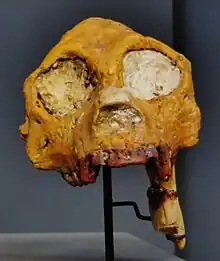 | |
| Aframonius[2] | Aframonius dieides | Lower Sequence | Quarry L-41 | Three partial mandibles. | An adapid primate | |
| Afrotarsius[54] | Afrotarsius chatrathi | Upper Sequence | Quarry M | A single mandible. | A primate of controversial classification. It reached an estimated bodymass of 130–300 g (4.6–10.6 oz). | |
| Anchomomys[3][2] | Anchomomys milleri | Lower Sequence | Quarry L-41 | |||
| Apidium bowni | Upper Sequence | Quarry V |
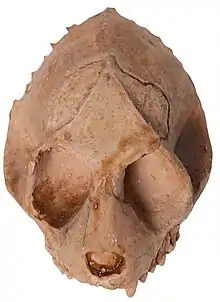 | |||
| Apidium moustafai | Upper Sequence | Quarry G | ||||
| Apidium phiomense | Upper Sequence | Various remains including cranial and limb bones. | A parapithecid primate known from a rich fossil record. Apidium phiomense is the type species and one of the first primates described from Jebel Qatrani. | |||
| Arsinoea[55][56] | Arsinoea kallimos | Lower Sequence | Quarry L-41 | A mandible with teeth | A parapithecid primate. | |
| Catopithecus[55][54][57] | Catopithecus browni | Lower Sequence | Quarry L-41 | Over 16 specimens including crania, mandibles and postcranial remains. | A very common species of oligopithecid. It was similar in size to large callitrichid primates and smaller night monkeys, squirrel monkeys and titi monkeys. Its teeth suggest a diet of leaves. |  |
| Oligopithecus[54] | Oligopithecus savagei | Lower Sequence | Quarry E | A partial hemimandible and isolated teeth. | A rarer species of oligopithecid. Members of this family are almost absent in the upper sequence of the formation, which may be a delayed result of climate change during the Eocene-Oligocene transition. The teeth of Oligopithecus indicate it may have been a frugivore. | |
| Oligopithecidae indet.[54] | Upper Sequence | Quarry M | A left hemimandible with alveoli for all teeth and a single, mostly complete molar tooth. | The smallest known oligopithecid and one of the smallest anthropoids. It is comparable in body mass to modern marmosets of the genus Callithrix and has been noted to be smaller than the fat-tailed dwarf lemur. | ||
| Parapithecus[54][2] | Parapithecus fraasi | Upper Sequence | A complete mandible. | A parapithecid primate. It has been suggested to by a synonym of Apidium, however this view is not universally accepted. | ||
| Plesiopithecus[56] | Plesiopithecus teras | Lower Sequence | Quarry L-41 | A mandible and a nearly complete skull. | An enigmatic lemur-like primate belonging to the family Plesiopithecidae. It may be related to the modern aye-aye. |
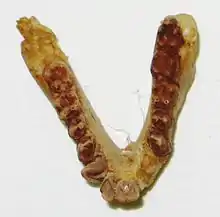 |
| Propliopithecus ankeli | Upper Sequence | Quarry V | Dental material. | |||
| Propliopithecus haeckeli | Multiple remains. | A propliopithecid primate from the upper sequences of the formation. Moeripithecus and Aelopithecus considered to be a synonym of this taxon. | ||||
| Proteopithecus[57][2] | Proteopithecus sylviae[55] | Lower Sequence | Quarry L-41 | A left maxillary fragment and additional remains including a partial skull. | A proteopithecid primate. | |
| Qatrania basiodontos | Lower Sequence | Quarry L-41 | Mandibular remains | Originally described as Abuqatrania basiodontos. | ||
| Qatrania fleaglei | Upper Sequence | Quarry M | A fragmentary hemimandible. | A parapithecid primate with an estimated bodymass of 300–500 g (11–18 oz). | ||
| Qatrania wingi | Lower Sequence | Quarry E | Fragmentary dentail remains. | A small parapithecid primate weighing less than 300 g (11 oz). | ||
| Serapia[55][2] | Serapia eocaena | Lower Sequence | Quarry L-41 | A partial mandible | A proteopithecid primate. | |
| Simonsius[2] | Simonsius grangeri | Upper Sequence | Quarry I | A mandibular fragment. | A disputed genus of proteopithecid primate. It was originally named as a species of Parapithecus, but later raised to its own genus. However, this is not universally accepted. |  |
| Wadilemur[2] | Wadilemur elegans | Lower Sequence | Quarry L-41 | A possible lorisiform. | ||
Proboscidea
| Name | Species | Member | Locality | Material | Notes | Image |
|---|---|---|---|---|---|---|
| Moeritherium[2] | Moeritherium trigodon | A right mandibular ramus and other remains. | A small, possibly semi-aquatic proboscidean roughly the size of a tapir. M. trigodon has some features of its dentition that may suggest that it could be a genus distinct from Moeritherium. Another species was also named from the formation, M. andrewsi, but modern research has drastically cut down on the amount of valid species, with most now being lumped into either the type species of M. trigodon. | 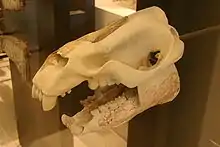 | ||
| Palaeomastodon beadnelli | Mandibular remains. | An early proboscidean named by Andrews in 1901. It is the type species of the genus Palaeomastodon. Unlike Moeritherium, Palaeomastodon and Phiomia are considered to have been terrestrial animals. |
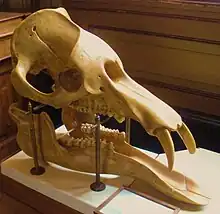 | |||
| Palaeomastodon minor | A species distinguished from P. beadnelli through its smaller size. The status of most Palaeomastodon species is complex and has been discussed repeatedly. | |||||
| Palaeomastodon parvus | Another small species of Palaeomastodon. | |||||
| Palaeomastodon wintoni | Although morphologically similar to P. minor it was slightly larger, but fails to approach the size of the type species. It is the most common species in the formation. | |||||
| Phiomia[2] | Phiomia serridens | Various remains | Although multiple species have been named in the past, Phiomia serridens is currently the only valid species of this genus native to Fayum. Species of Palaeomastodon were at times also assigned to Phiomia. | 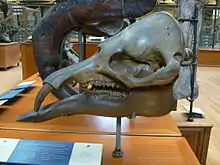 | ||
Sirenia
| Name | Species | Member | Locality | Material | Notes | Image |
|---|---|---|---|---|---|---|
| Eosiren[59][60] | Eosiren imenti | Upper Sequence | Quarry O | Skull and ribs. | E. imenti is the most derived member of the genus Eosiren and had an elongated head. |  |
See also
- Geologic formations of Egypt
- List of fossil sites
References
- Rasmussen, D.T.; Olson, S.L.; Simons, E.L. (1987). "Fossil birds from the Oligocene Jebel Qatrani formation Fayum Province, Egypt". Smithsonian Contributions to Paleobiology. 62 (62): 1–20. doi:10.5479/si.00810266.62.1.
- Kampouridis, P.; Hartung, J.; Augustin, F.J. (2023). "The Eocene–Oligocene Vertebrate Assemblages of the Fayum Depression, Egypt". The Phanerozoic Geology and Natural Resources of Egypt. Advances in Science, Technology & Innovation. pp. 373–405. doi:10.1007/978-3-030-95637-0_14. ISBN 978-3-030-95636-3.
- Seiffert Erik R. (Jan 2006). "Revised age estimates for the later Paleogene mammal faunas of Egypt and Oman". Proceedings of the National Academy of Sciences of the United States of America. 103 (13): 5000–5005. Bibcode:2006PNAS..103.5000S. doi:10.1073/pnas.0600689103. PMC 1458784. PMID 16549773.
- Murray, A.M. (2004). "Late Eocene and early Oligocene teleost and associated ichthyofauna of the Jebel Qatrani Formation, Fayum, Egypt". Palaeontology. 47 (3): 711–724. Bibcode:2004Palgy..47..711M. doi:10.1111/j.0031-0239.2004.00384.x. S2CID 140627361.
- Rasmussen, D. T.; Simons, E.L.; Hertel, F.; Judd, A. (2001). "Hindlimb of a giant terrestrial bird from the upper Eocene, Fayum, Egypt". Palaeontology. 44 (2): 325–337. Bibcode:2001Palgy..44..325R. doi:10.1111/1475-4983.00182. S2CID 130033734.
- Gaffney, E.S.; Meylan, P.A.; Wood, R.C.; Simons, E.; de Almeida Campos, D. (2011). "Evolution of the side-necked turtles: the family Podocnemididae". Bulletin of the American Museum of Natural History. 350: 1–237. doi:10.1206/350.1. hdl:2246/6110. S2CID 83775718.
- Pérez-García, A. (2017). "New information and establishment of a new genus for the Egyptian Paleogene turtle "Stereogenys" libyca (Podocnemididae, Erymnochelyinae)". Historical Biology. 31 (3): 1–10. doi:10.1080/08912963.2017.1374383. S2CID 90915135.
- Brochu, C.A.; Gingerich, P.D. (2000). "New tomistomine crocodylian from the middle Eocene (Bartonian) of Wadi Hitan, Fayum Province, Egypt" (PDF). Contributions from the Museum of Paleontology the University of Michigan. 30 (10): 251–268.
- Gaffney, E.S.; Deblieux, D.D.; Simons, E.L.; Sánchez-Villagra, M.R.; Meylan, P.A. (2002). "Redescription of the Skull of Dacquemys, a Podocnemidid Side-Necked Turtle from the Late Eocene of Egypt". American Museum Novitates (372): 1–16. doi:10.1206/0003-0082(2002)372<0001:ROTSOD>2.0.CO;2. S2CID 55263374.
- Holroyd, P.A.; Parham, J.F. (2003). "The antiquity of African tortoises". Journal of Vertebrate Paleontology. 23 (3): 688–690. Bibcode:2003JVPal..23..688H. doi:10.1671/1870. S2CID 86348004.
- Seiffert, E.R. (2010). "The oldest and youngest records of afrosoricid placentals from the Fayum Depression of northern Egypt". Acta Palaeontologica Polonica. 55 (4): 599–616. doi:10.4202/app.2010.0023. S2CID 910171.
- Simons, E.L.; Holroyd, P.A.; Bown, T.M. (1991). "Early tertiary elephant-shrews from Egypt and the origin of the Macroscelidea". Proceedings of the National Academy of Sciences. 88 (21): 9734–9737. Bibcode:1991PNAS...88.9734S. doi:10.1073/pnas.88.21.9734. PMC 52794. PMID 11607230.
- Pickford, M. (2019). "Tiny Tenrecomorpha (Mammalia) from the Eocene of Black Crow, Namibia" (PDF). Communications of the Geological Survey of Namibia. 21: 15–25.
- Sileem, A.H.; Sallam, H.M.; Hewaidy, A.G.A.; Gunnell, G.F.; Miller, E.R. (2015). "Anthracotheres (Mammalia, Artiodactyla) from the upper-most horizon of the Jebel Qatrani formation, latest Early Oligocene, Fayum depression, Egypt". Egyptian Journal of Paleontology. 15: 1–11. ISSN 1687-4986.
- Holroyd, P.A.; Simons, E.L.; Bown, T.M.; Polly, P.D.; Kraus, M.J. (1996). "New records of terrestrial mammals from the upper Eocene Qasr el Sagha Formation, Fayum Depression, Egypt" (PDF). Palaeovertebrata. 25 (2–4): 175–192.
- Sileem, A.H.; Abu El‐Kheir, G.A. (2022). "Complete skull of Bothriogenys fraasi (Mammalia, Artiodactyla, Anthracotheriidae) from the Early Oligocene, Fayum, Egypt". Geological Journal. 57 (11): 4833–4841. doi:10.1002/gj.4574. S2CID 252244244.
- O'Leary, M.A.; Patel, B.A.; Coleman, M.N. (2012). "Endocranial petrosal anatomy of Bothriogenys (Mammalia, Artiodactyla, Anthracotheriidae), and petrosal volume and density comparisons among aquatic and terrestrial artiodactyls and outgroups". Journal of Paleontology. 86 (1): 44–50. Bibcode:2012JPal...86...44O. doi:10.1666/10-091.1. S2CID 85238250.
- Sileem, A.H.; Sallam, H.M.; Hewaidy, A.G.A.; Miller, E.R.; Gunnell, G.F. (2016). "A new anthracothere (Artiodactyla) from the early Oligocene, Fayum, Egypt, and the mystery of African 'Rhagatherium' solved". Journal of Paleontology. 90 (1): 170–181. Bibcode:2016JPal...90..170S. doi:10.1017/jpa.2016.13. S2CID 132618649.
- Patricia A. Holroyd, Fabrice Lihoreau, Gregg F. Gunnell und Ellen R. Miller: Anthracotheriidae. In: Lars Werdelin und William Joseph Sanders (Hrsg.): Cenozoic Mammals of Africa. University of California Press, Berkeley, Los Angeles, London, 2010, S. 843–851
- Simmons, N.B.; Seiffert, E.R.; Gunnell, G.F. (2016). "A new family of large omnivorous bats (Mammalia, Chiroptera) from the Late Eocene of the Fayum Depression, Egypt, with comments on use of the name "Eochiroptera"" (PDF). American Museum Novitates (3857): 1–43. doi:10.1206/3857.1. ISSN 0003-0082. S2CID 87290447.
- Gunnell, G. F.; Simons, E. L.; Seiffert, E. R. (2008). "New bats (Mammalia: Chiroptera) from the late Eocene and early Oligocene, Fayum Depression, Egypt". Journal of Vertebrate Paleontology. 28 (1): 1–11. doi:10.1671/0272-4634(2008)28[1:nbmcft]2.0.co;2. S2CID 86125632.
- Gunnell, G.F.; Simmons, N.B.; Seiffert, E.R. (2014). "New Myzopodidae (Chiroptera) from the Late Paleogene of Egypt: Emended Family Diagnosis and Biogeographic Origins of Noctilionoidea". PLOS ONE. 9 (2): e86712. Bibcode:2014PLoSO...986712G. doi:10.1371/journal.pone.0086712. PMC 3913578. PMID 24504061.
- Court, N. (1990). "Periotic anatomy of Arsinoitherium (Mammalia, Embrithopoda) and its phylogenetic implications". Journal of Vertebrate Paleontology. 10 (2): 170–182. Bibcode:1990JVPal..10..170C. doi:10.1080/02724634.1990.10011806.
- Vialle, N.; Merzeraud, G.; Delmer, C.; Feist, M.; Jiquel, S.; Marivaux, L.; Ramdarshan, A.; Vianey-Liaud, M.; Essid, E.M.; Marzougui, W.; Ammar, H.K.; Tabuce, R. (2013). "Discovery of an Embrithopod Mammal (Arsinoitherium?) in the Late Eocene of Tunisia". Journal of African Earth Sciences. 87: 86–92. Bibcode:2013JAfES..87...86V. doi:10.1016/j.jafrearsci.2013.07.010.
- Borths, M.R.; Holroyd, P.A.; Seiffert, E.R. (2016). "Hyainailourine and teratodontine cranial material from the late Eocene of Egypt and the application of parsimony and Bayesian methods to the phylogeny and biogeography of Hyaenodonta (Placentalia, Mammalia)". PeerJ. 4: e2639. doi:10.7717/peerj.2639. PMC 5111901. PMID 27867761.
- Osborn, H.F. (1909). "New carnivorous mammals from the Fayûm Oligocene, Egypt" (PDF). Bulletin of the American Museum of Natural History. 26: 415–424.
- Holroyd, P.A. (1999). "New Pterodontinae (Creodonta: Hyaenodontidae) from the late Eocene-early Oligocene Jebel Qatrani Formation, Fayum province, Egypt". PaleoBios. 19 (2): 1–18.
- Simons, E.L.; Gingerich, P.D. (1976). "A new species of Apterodon (Mammalia, Creodonta) from the upper Eocene Qasr el-Sagha Formation of Egypt". Postilla of the Peabody Museum of Natural History.
- Lange-Badré, B.; Böhme, M. (2005). "Apterodon intermedius, sp. nov., a new European creodont mammal from MP22 of Espenhain (Germany)". Annales de Paléontologie. 91 (4): 311–328. Bibcode:2005AnPal..91..311L. doi:10.1016/j.annpal.2005.08.001.
- Borths, M.R.; Seiffert, E.R. (2017). "Craniodental and humeral morphology of a new species of Masrasector (Teratodontinae, Hyaenodonta, Placentalia) from the late Eocene of Egypt and locomotor diversity in hyaenodonts". PLOS ONE. 12 (4): e0173527. Bibcode:2017PLoSO..1273527B. doi:10.1371/journal.pone.0173527. PMC 5396875. PMID 28422967.
- Borths, M.R.; Stevens, N.J. (2017). "The first hyaenodont from the late Oligocene Nsungwe Formation of Tanzania: Paleoecological insights into the Paleogene-Neogene carnivore transition". PLOS ONE. 12 (10): e0185301. Bibcode:2017PLoSO..1285301B. doi:10.1371/journal.pone.0185301. PMC 5636082. PMID 29020030.
- Morales, J.; Pickford, M. (2017). "New hyaenodonts (Ferae, Mammalia) from the early Miocene of Napak (Uganda), Koru (Kenya) and Grillental (Namibia)". Fossil Imprint. 73 (3–4): 332–359. doi:10.2478/if-2017-0019. hdl:10261/195968. S2CID 31350436.
- Solé, F.; Lhuillier, J.; Adaci, M.; Bensalah, M.; Mahboubi, M.; Tabuce, R. (2014). "The hyaenodontidans from the Gour Lazib area (? early Eocene, Algeria): implications concerning the systematics and the origin of the Hyainailourinae and Teratodontinae". Journal of Systematic Palaeontology. 12 (3): 303–322. doi:10.1080/14772019.2013.795196. S2CID 84475034.
- Andrews, C.W. (1906). "A descriptive catalogue of the Tertiary Vertebrata of the Fayum, Egypt". Order of the Trustees of the British Museum.
- Morlo, M.; Bastl, K.; Wenhao, W.; Schaal, S.F.K. (2014). "The first species of Sinopa (Hyaenodontida, Mammalia) from outside of North America: implications for the history of the genus in the Eocene of Asia and North America". Palaeontology. 57 (1): 111–125. Bibcode:2014Palgy..57..111M. doi:10.1111/pala.12052. S2CID 129633205.
- Rasmussen, D.T.; Simons, E.L. (2000). "Ecomorphological diversity among Paleogene hyracoids (Mammalia): a new cursorial browser from the Fayum, Egypt". Journal of Vertebrate Paleontology. 20 (1): 167–176. doi:10.1671/0272-4634(2000)020[0167:EDAPHM]2.0.CO;2. S2CID 85172473.
- De Blieux, D.D.; Simons, E.L. (2002). "Cranial and dental anatomy of Antilohyrax pectidens: a late Eocene hyracoid (Mammalia) from the Fayum, Egypt". Journal of Vertebrate Paleontology. 22 (1): 122–136. doi:10.1671/0272-4634(2002)022[0122:CADAOA]2.0.CO;2. S2CID 87901588.
- De Blieux, D.D.; Baumrind, M.R.; Simons, E.L.; Chatrath, P.S.; Meyer, G.E.; Attia, Y.S. (2006). "Sexual dimorphism of the internal mandibular chamber in Fayum Pliohyracidae (Mammalia)". Journal of Vertebrate Paleontology. 26 (1): 160–169. doi:10.1671/0272-4634(2006)26[160:SDOTIM]2.0.CO;2. S2CID 85657104.
- Meyer, G.E. (1973). "A new Oligocene hyrax from the Jebel el Qatrani formation, Fayum, Egypt" (PDF). Peabody Museum of Natural History, Yale University.
- Tabuce, R. (2016). "A mandible of the hyracoid mammal Titanohyrax andrewsi in the collections of the Muséum National d'Histoire Naturelle, Paris (France) with a reassessment of the species". Palaeovertebrata. 40 (1): e4. doi:10.18563/pv.40.1.e4.
- Rasmussen, D. T.; Simons, E. L. (1988). "New Oligocene hyracoids from Egypt". Journal of Vertebrate Paleontology. 8 (1): 67–83. Bibcode:1988JVPal...8...67R. doi:10.1080/02724634.1988.10011684.
- Matsumoto, H. (1922). "Megalohyrax, Andrews and Titanohyrax, gen. nov. A revision of the genera of hyracoids from the Fayum, Egypt". Proceedings of the Zoological Society (1921): 839–850.
- Rasmussen, D.T.; Simons, E.L. (1991). "The Oldest Egyptian Hyracoids (Mammalia: Pliohyracidae): New Species of Saghatherium and Thyrohyrax from the Fayum". Neues Jahrbuch für Geologie und Paläontologie. 182 (2): 187–209. doi:10.1127/njgpa/182/1991/187.
- Hooker, J.J.; Sánchez-Villagra, M.R.; Goin, F.J.; Simons, E.L.; Attia, Y.; Seiffert, E.R. (2008). "The origin of Afro‐Arabian 'didelphimorph'marsupials". Palaeontology. 51 (3): 635–648. Bibcode:2008Palgy..51..635H. doi:10.1111/j.1475-4983.2008.00779.x. S2CID 129506768.
- Al-Ashqar, SF; Seiffert, E.R.; de Vries, D.; El-Sayed, S.; Antar, M.S.; Sallam, H.M. (2021). "New phiocricetomyine rodents (Hystricognathi) from the Jebel Qatrani Formation, Fayum Depression, Egypt". PeerJ. 9: e12074. doi:10.7717/peerj.12074. PMC 8533026. PMID 34721955.
- Sallam, H.M.; Seiffert, E.R.; Simons, E.L. (2012). "A basal phiomorph (Rodentia, Hystricognathi) from the late Eocene of the Fayum Depression, Egypt". Swiss Journal of Palaeontology. 131 (2): 283–301. doi:10.1007/s13358-012-0039-6. S2CID 84516606.
- Sallam, H.M.; Seiffert, E.R. (2016). "New phiomorph rodents from the latest Eocene of Egypt, and the impact of Bayesian "clock"-based phylogenetic methods on estimates of basal hystricognath relationships and biochronology". PeerJ. 4: e1717. doi:10.7717/peerj.1717. PMC 4782727. PMID 26966657.
- Sallam, H.M.; Seiffert, E.R.; Simons, E.L. (2011). "Craniodental Morphology and Systematics of a New Family of Hystricognathous Rodents (Gaudeamuridae) from the Late Eocene and Early Oligocene of Egypt". PLOS ONE. 6 (2): e16525. Bibcode:2011PLoSO...616525S. doi:10.1371/journal.pone.0016525. PMC 3043065. PMID 21364934.
- Sallam, H.M.; Seiffert, E.R. (2020). "Revision of Oligocene 'Paraphiomys' and an origin for crown Thryonomyoidea (Rodentia: Hystricognathi: Phiomorpha) near the Oligocene–Miocene boundary in Africa". Zoological Journal of the Linnean Society. 190 (1): 352–371. doi:10.1093/zoolinnean/zlz148.
- Jaeger, J.J.; Marivaux, L.; Salem, M.; Bilal, A.A.; Benammi, M.; Chaimanee, Y.; Duringer, P.; Marandat, B.; Métais, E.; Schuster, M.; Valentin, X.; Brunet, M. (2010). "New rodent assemblages from the Eocene Dur At-Talah escarpment (Sahara of central Libya): systematic, biochronological, and palaeobiogeographical implications" (PDF). Zoological Journal of the Linnean Society. 160 (1): 195–213. doi:10.1111/j.1096-3642.2009.00600.x.
- Bown, T.M.; Simons, E.L. (1987). "New Oligocene Ptolemaiidae (Mammalia: ?Pantolesta) from the Jebel Qatrani Formation, Fayum Depression, Egypt". Journal of Vertebrate Paleontology. 7 (3): 311–324. Bibcode:1987JVPal...7..311B. doi:10.1080/02724634.1987.10011662.
- Simons, E.L.; Bown, T.M. (1995). "Ptolemaiida, a new order of Mammalia--with description of the cranium of Ptolemaia grangeri". Proc Natl Acad Sci USA. 92 (8): 3269–73. Bibcode:1995PNAS...92.3269S. doi:10.1073/pnas.92.8.3269. PMC 42147. PMID 11607526.
- Osborn, H. F. (1908). "New fossil mammals from the Fayum Oligocene, Egypt". Bulletin of the American Museum of Natural History. 24: 265–272.
- Seiffert, E. R.; Simons, E. L. (2013). "Last of the oligopithecids? A dwarf species from the youngest primate-bearing level of the Jebel Qatrani Formation, northern Egypt". Journal of Human Evolution. 64 (3): 211–215. doi:10.1016/j.jhevol.2012.10.011. PMID 23416038.
- Simons, E. L.; Seiffert, E. R.; Chatrath, P. S.; Attia, Y. (2001). "Earliest Record of a Parapithecid Anthropoid from the Jebel Qatrani Formation, Northern Egypt". Folia Primatologica. 72 (6): 316–331. doi:10.1159/000052748. PMID 11964500. S2CID 34259124.
- Simons, E. L. (1992). "Diversity in the early Tertiary anthropoidean radiation in Africa". Proceedings of the National Academy of Sciences. 89 (22): 10743–10747. Bibcode:1992PNAS...8910743S. doi:10.1073/pnas.89.22.10743. PMC 50418. PMID 1438271.
- Simons, E.L. (1989). "Description of two genera and species of late Eocene Anthropoidea from Egypt". Proceedings of the National Academy of Sciences. 86 (24): 9956–9960. Bibcode:1989PNAS...86.9956S. doi:10.1073/pnas.86.24.9956. PMC 298621. PMID 2513576.
- Simons, E.L.; Kay, R.F. (1983). "Qatrania, new basal anthropoid primate from the Fayum, Oligocene of Egypt". Nature. 304 (5927): 624–626. Bibcode:1983Natur.304..624S. doi:10.1038/304624a0. S2CID 4232974.
- Domning, D.P.; Gingerich, P.D.; Zalmout, I.S. (2010). "14: Sirenia". Cenozoic Mammals of Africa. pp. 147–160.
- Domning, D.P.; Gingerich, P.D.; Simons, E.L.; Ankel-Simons, F.A. (1994). "A new early Oligocene dugongid (Mammalia, Sirenia) from Fayum Province, Egypt" (PDF). Contributions from the Museum of Paleontology the University of Michigan. 29 (4).